José David Rosales1*, Helga Sarti2, Carlos Porras3, Alejandra Duque4, Natalia Casasola4
1Dermatologist at Centro de Especialidades Médicas de Oriente, Jutiapa, Guatemala
2Dermatopathologist at Dermopatologia Clinica e Histología de Piel, Guatemala, Guatemala
3Msc. Mycology at Biotonix Laboratory, Guatemala, Guatemala
4Medical Resident at Hospital El Pilar, Guatemala, Guatemala
*Correspondence author: José David Rosales, Dermatologist at Centro de Especialidades Médicas de Oriente, Jutiapa, Guatemala;
Email: [email protected]
Published Date: 31-10-2024
Copyright© 2024 by Rosales JD, et al. All rights reserved. This is an open access article distributed under the terms of the Creative Commons Attribution License, which permits unrestricted use, distribution, and reproduction in any medium, provided the original author and source are credited.
Abstract
Chromoblastomycosis (CBM) is one of the most prevalent subcutaneous mycoses, caused by melanized or pigmented fungi. Considered a tropical or subtropical disease, commonly seen in rural areas after traumatic inoculation, mostly associated with agriculture. The lesions tend to present on the limbs and follow a chronic and progressive pattern, which if left untreated or misdiagnosed can lead to loss of functionality and lower quality of life. Teledermatology (TD) has been used mainly to diagnose, monitor and treat patients at distance in neglected areas. Guatemala has a vast rural area and despite the efforts from both private and public sectors, we still cannot reach all the patients and not all the patients can reach us. We present a case report on how with the aid of teledermatology a life was changed for the good.
Keywords: Chromoblastomycosis; Subcutaneous Mycosis; Fonsecae Spp; Guatemala; Teledermatology
Case Report
We present the case of a 60-year-old male patient, dedicated to agriculture living in a rural area in Guatemala, far away from the main cities [1-3]. He consulted many general physicians close to home due to a lesion on his left leg, which progressed for 10 years preventing him from regular activities and work. In his last consultation, he was offered amputation due to suspicion of cancer. Jointly with his family, they tried their best to find a second opinion, finding out the teledermatology service of our clinic. They sent pictures of the lesion (Fig. 1,2) in which we observed a chronic dermatosis located on the left leg characterized by multiple red swollen scaly and cicatricial plaques presenting ulcers, covered with fibrin and granular structures on their borders, accompanied by red papules and nodules. Based on these photographic findings an appointment for skin biopsy and cultures was made.
Under direct microscopy with KOH, we found fumagoid cells (Fig. 3). Mycology described macroscopic findings as small velvety colonies with a dark green color on the front and black on their back (Fig. 4,5) microscopic findings revealed the formation of conidia in phialides (Fig. 6), compatible with Fonsecaea pedrosoi. On histopathology the dermis, was filled with suppurative granulomas surrounding fungi structures that simulate “coffee grains”, sclerotic bodies (Fig. 7,8). Confirming the diagnosis of Chromoblastomycosis. The patient has been under treatment with itraconazole 200 mg/day in the last 6 months showing major clinical improvement (Fig. 9).

Figure 1: Lesion on anterior leg at the time of first consultation.

Figure 2: Lesion on posterior leg at the time of first consultation.
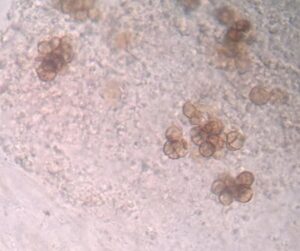
Figure 3: Fumagoid cells under direct microscopy.
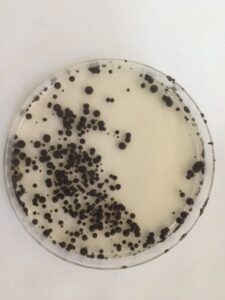
Figure 4: Dark-green velvety colonies.
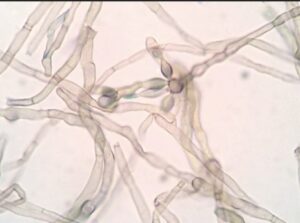
Figure 5: Conidia and phialide fungal structures.

Figure 6: Histopathology: suppurative granulomatous reaction.
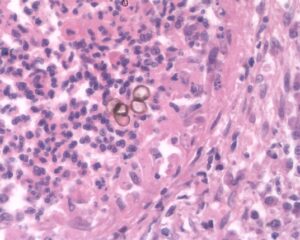
Figure 7: Sclerotic bodies (coffee grain structures).
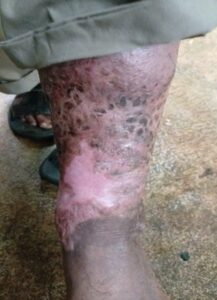
Figure 8: Lesion on anterior leg after 6 month of treatment with itraconazole.
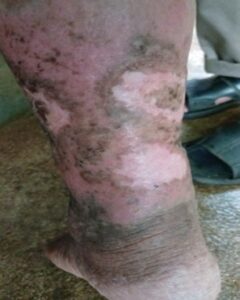
Figure 9: Lesion on posterior leg after 6 month of treatment with Itraconazole.
Discussion
Teledermatology uses modern technologies to reach out patients in distant areas. It has been classified according to how the patient interacts with the practitioner, 1) Primary, 2) Secondary, 3) Tertiary, 4) Patient Assisted, 5) Direct to consumer [4]. Because around the globe most dermatologists concentrate in urban areas, populations like rural, low-income, uninsured, minorities or under other special conditions are left with limited access to dermatologic care. A study in Philadelphia showed that 61% of the attended patients by TD would have not been attended; in India revealed an 81% cost reduction from dermatology care in distant areas, thanks to TD [2-4]. A study in Brazil proved 80% concordance of TD diagnosis with histopathologic diagnosis. In her review Ahuja, S. concludes that TD is an accurate tool for diagnosing and managing skin conditions, improving the timeliness of care and reducing the distance and cost to receive dermatologic care [5]. Chromoblastomycosis is a tropical or subtropical disease, mainly seen in Latin America, prevailing in low-income populations with limited access to travel outside their hamlet [1-3]. CBM is classified as a subcutaneous fungal infection or implantation mycoses. Agents causing this condition belong to the fungal order of Chaetothyriales, being Fonsecaea spp, Philophora verrucosa, Cladophialophora carrionii, Exophialia dermatitidis and Rhinocladiella aquaspersa the most common species [1]. Clinical history is a lesion that initiates after a traumatic event, on exposed areas, prevalence is higher on lower limbs and hands, as a small macular or papular lesion that presents slow growth and morphological changes, often producing satellite lesions, edema and host tissue hypertrophy. It can be classified as mild, moderate and severe or as nodular, verrucous, tumorous, cicatricial, plaque or mixed, according to severity or clinical presentation [1,3]. The diagnosis is confirmed by direct microscopic culture and histopathological examination [2]. Treatment can be divided in 2 major categories. Physical methods, including: conventional surgery, Cryotherapy, Heat therapy, Laser and Photodynamic therapy. Systemic methods, in which Itraconazole stands as the first line treatment, having success rates up to 80% from cases, followed by terbinafine as the second line treatment [1,2].
Conclusion
Worldwide access to proper dermatologic care is needed, that includes our country, Guatemala. Chromoblastomycosis is a hard to diagnose, even for dermatologists, but the initial picture proved to be enough to avoid our patient undergoing an amputation procedure. Considering the implications of this procedure on a farmer, teledermatology demonstrated to be a life-saving technology. Proving the need for every dermatologist working either in the private or public sector to provide this kind of service.
Conflict of Interest
The authors declare they do not have conflicts of interest.
References
- Queiroz-Telles F, de Hoog S, Santos DWCL, Salgado CG, Vicente VA, Bonifaz A, et al. Chromoblastomycosis. Clin Microbiol Rev. 2017;30(1):233-76.
- Brito AC de, Bittencourt M de JS. Chromoblastomycosis: an etiological, epidemiological, clinical, diagnostic and treatment update. An Bras Dermatol. 2018;93(4):495-506.
- Assefa W, Sinatayehu R, Sendeku MA, Dires M. Chromoblastomycosis: delayed diagnosis with extensive cutaneous lesions. Int J Infect Dis. 2023;131:50-2.
- Pasquali P, Sonthalia S, Moreno-Ramirez D, Sharma P, Agrawal M, Gupta S, et al. Teledermatology and its current perspective. Indian Dermatol Online J. 2020;11(1):12.
- Ahuja S, Briggs SM, Collier SM. Teledermatology in rural, underserved and isolated environments: a review. Curr Dermatol Rep. 2022;11(4):328-35.
- Cohn E. Teledermatology: a postpandemic update. Cutis. 2023;112(5).
Article Type
Case Report
Publication History
Received Date: 11-10-2024
Accepted Date: 24-10-2024
Published Date: 31-10-2024
Copyright© 2024 by Rosales JD, et al. All rights reserved. This is an open access article distributed under the terms of the Creative Commons Attribution License, which permits unrestricted use, distribution, and reproduction in any medium, provided the original author and source are credited.
Citation: Rosales JD, et al. A Good Diagnosis Saves Lives: The Importance of Teledermatology: Case Report. J Dermatol Res. 2024;5(3):1-6.

Figure 1: Lesion on anterior leg at the time of first consultation.

Figure 2: Lesion on posterior leg at the time of first consultation.

Figure 3: Fumagoid cells under direct microscopy.

Figure 4: Dark-green velvety colonies.

Figure 5: Conidia and phialide fungal structures.

Figure 6: Histopathology: suppurative granulomatous reaction.

Figure 7: Sclerotic bodies (coffee grain structures).

Figure 8: Lesion on anterior leg after 6 month of treatment with itraconazole.

Figure 9: Lesion on posterior leg after 6 month of treatment with Itraconazole.


